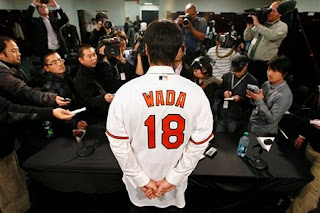So far throughout Free Agency the same names have been mentioned: Albert Pujols, Prince Fielder, Jose Reyes, C.J. Wilson, and… Yoenis Cespedes.
Yoenis Cespedes (pictured above) is a 26-year-old Cuban outfielder who defected from Cuba to the Dominican Republic this summer. Cespedes’ plan was to finally become a Major League baseball player.
The first thing Cespedes did was send out a promotion video to all 30 MLB teams, a very interesting video to say the least. Here is a link for those of you who haven’t seen it:
Cespedes' Showcase (Warning this video contains explicit language).
When it comes to stats, Cespedes has put out some very impressive numbers in his playing career. Since debuting in the Cuban National Series in the 2003-04 season, Cespedes has hit over .300 almost every single year except for 2007-08 season. He also hit 175 home runs in 9 seasons, showing that he clearly has power. Besides hitting, Cespedes has above-average speed, but isn’t known for his stealing ability. In the field Cespedes is an average defender and reports say he has an above average arm.
So far plenty of teams have been interested in the Cuban outfielder. Teams have ranged from the Yankees and Redsox, to teams like the Pirates and the Indians. The Orioles have also expressed interest in Cespedes.
However, the price for Cespedes continues to climb. Reports say it could take $50-60 million to sign him. But should the O’s spend that much money on a player who hasn’t constantly faced major-league competition?
No, the Orioles should not spend that much money on Yoenis Cespedes.
Signing Cespedes would be like signing a player like Mike Cameron. Yes, Cameron was an average to above-average player in his prime, but would he be worth $60 million or more?!?
There is another international prospect that the Orioles should go after though.
19-year-old Cuban outfielder Jorge Soler is not drawing nearly the same amount of attention, but he may be well worth the wait.
Unlike Cespedes, Soler is not major-league ready. Scouts say it will take him 2 or 3 years in the minors, but Soler could turn out to be a better major-league player than Cespedes. Soler is known to have great bat speed and could become a hitter that hits 40 home runs in the major-leagues. Soler will also come a lot cheaper. Soler is expected to get a deal similar to Rangers centerfielder Leonys Martin, who signed a 5-year major-league contract worth $15.5 million.
Soler may not be major-league ready, but he has a ton of raw potential and having a 6’3” frame, he has a ton of potential as a power hitter.
Signing someone like Jorge Soler will be cheaper than spending money on Yoenis Cespedes and Dan Duquette will stick to his word by focusing on more international signing and development of prospects.











